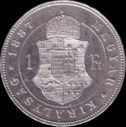
Back الفلورين النمساوي المجري Arabic جولدن النمساوى المجرى ARZ Avstriya-Macarıstan quldeni Azerbaijani Австро-унгарски гулден Bulgarian Rakousko-uherský zlatý Czech Österreichisch-ungarischer Gulden German Aŭstria-hungara guldeno Esperanto گولدن اتریش-مجارستان Persian Florin austro-hongrois French פורינט אוסטרו-הונגרי HE
| |||||
| Unit | |||||
| Symbol | Fl. (in Latin), Ft. (in Hungarian) | ||||
| Denominations | |||||
| Subunit | |||||
| 1⁄60 (to 1857) 1⁄100 (after) | kreuzer | ||||
| Banknotes | 1, 5, 10, 50, 100, 1,000 gulden | ||||
| Coins | 5⁄10, 1, 4, 5, 10, 20 kreuzer; 1⁄4, 1, 2, 4, 8 gulden; 1, 2 Vereinsthaler (1+1⁄2 Fl., 3 Fl.) | ||||
| Demographics | |||||
| Date of withdrawal | 1892 | ||||
| Replaced by | Austro-Hungarian krone | ||||
| User(s) | Austria-Hungary, Principality of Montenegro | ||||
| Issuance | |||||
| Central bank | Austro-Hungarian Bank | ||||
| This infobox shows the latest status before this currency was rendered obsolete. | |||||
The Austro-Hungarian gulden (German), also known as the florin (German & Croatian), forint (Hungarian; Croatian: forinta), or zloty (Polish: złoty reński; Czech: zlatý), was the currency of the lands of the House of Habsburg between 1754 and 1892 (known as the Austrian Empire from 1804 to 1867 and the Austro-Hungarian Monarchy after 1867), when it was replaced by the Austro-Hungarian krone as part of the introduction of the gold standard. In Austria, the gulden was initially divided into 60 kreuzers (German; Hungarian: krajczár; Croatian: krajcar; Czech: krejcar; Polish: krajcar). The currency was decimalized in 1857, using the same names for the unit and subunit.

